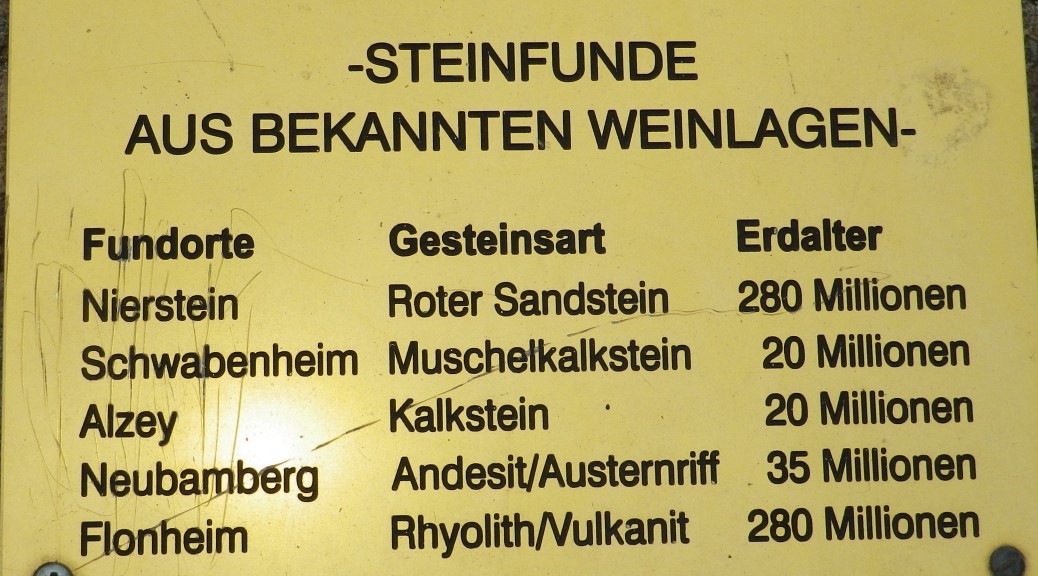What I Learned:
Off all the German states (or Laende), Rheinland Pfalz has the most wine regions. And of all the German wine regions, the Rheinhessen is the biggest. On the left/west bank of the Rhine, between roughly Worms and Mainz, it extends away from the river to as far west as Alzey-Weinheim, itself about 25 kilometers from the Rhine. In total, Rheinhessen vines cover approximately 26,000 hectares/65,000 acres.
One of the growth areas in this region is the Rheinterrassen or Rhine Terraces in the Nierstein District. These are literally the natural terraces lining the river on the west. These mostly red sandstone formations, dating back some 280 million years, are home to some of the vineyards bestowing a good reputation to wines from the area. The Gloeck, one of the oldest in Germany, is in Nierstein. It surrounds one of the earliest churches, Sankt Kilian, and probably served to provide wine for services. Its foundation dates to 742 AD. Some of the most distinguished vineyards are: Hipping and Oelberg, also in Nierstein; Oppenheim’s Sacktraeger and Kreuz; and Nackenheim’s Rotenberg. The Roterhang, or Red Slope, is one of the distinguishing landmarks in the area around Nierstein. And yes, the soil is noticeably red here.
While Riesling is well-known in this area, so is Silvaner. This ancient grape has grown here for centuries, if not millennia. Currently though, the most common varietal is Riesling which edges out Mueller-Thurgau at about 16.5 percent. (In the last century, Mueller-Thurgau blends produced the popular but extremely sweet, flaccid wines known as Liebfraumilch, denigrated as Zuckerwasser (sugar water) by German wine connoisseurs.) In all, white varietals result in about two-thirds of all wine production. And quality Rieslings from good, local producers are now quite sought after.
Common red varietals are Dornfelder, at about 13 percent, and Spaetburgunder/Pinot Noir.
The past Liebfraumilch production resulted in a reputation for poor quality wine. However, the quality, and just as importantly, the reputation of Rheinhessen wines is improving. Oppenheim hosts a Viticultural School, and a fair share of the vintners from this district of the Rheinhessen region are members of the prestigious Verband Deutscher Praedikatsweingueter, or Association of Predikat Wines Estates. VDP members are dedicated to very high wine quality standards, above those specified by law. Be advised though, such quality wines are not always easy to find outside the area, making a trip to the Rheinterrassen a must to experience them.
What I Tasted:
2013 Riesling, Nierstein Oelberg, Spaetlese, Trocken, Praedikatswein, Louis Guntrum Weinkellerei; a dry white wine with light gold color; with a mineral nose, flavors of peach, honey and spice, green apple tartness, but a smooth finish. Very interesting.
2013 Riesling, Oppenheimer Herrenberg, Spaetlese, Praedikatswein, Louis Guntrum Weinkellerei; an off-dry white wine with light gold color, mineral nose with mango and nut flavors, very slight acidity, refreshingly sweet.
2013 Silvaner, Alte Reben, Trocken, Qualitaetswein, Weingut Dr. Heydn: a dry white wine with light gold color; herbaceous and green apple nose, notes of citrus, pear and a hint of vanilla.
2012 Riesling, Edition Hofgut Laubenheimer Hoehe, Trocken, Weingut Kuehling-Gillot; a dry white wine with a light medium gold color; mineral scents, with flavors of honey, peach, vanilla, and melon, slight apple note on the finish; low acidity and very smooth. Layers of subtle flavors make this a delicious and interesting wine to drink.
